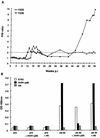Long-term follow-up of chimpanzees inoculated with the first infectious clone for hepatitis C virus
- PMID: 10074186
- PMCID: PMC104096
- DOI: 10.1128/JVI.73.4.3317-3325.1999
Long-term follow-up of chimpanzees inoculated with the first infectious clone for hepatitis C virus
Abstract
Two chimpanzees (Ch1535 and Ch1536) became infected with hepatitis C virus (HCV) following intrahepatic inoculation with RNA transcribed from a full-length cDNA clone of the virus. Both animals were persistently infected and have been followed for 60 weeks. They showed similar responses to infection, with transient liver enzyme elevations and liver inflammatory responses, which peaked at weeks 17 (Ch1535) and 12 (Ch1536) postinoculation (p.i.). Antibody responses to structural and nonstructural proteins were first detected at weeks 13 (Ch1535) and 10 (Ch1536) p.i. Serum RNA titers increased steadily during the first 10 to 13 weeks but decreased sharply in both animals following antibody and inflammatory responses. Despite direct evidence of humoral immune responses to multiple viral antigens, including hypervariable region 1 (HVR1), both animals remained chronically infected. Detailed sequence analysis of serum HCV RNA revealed no change in the majority HVR1 sequence in Ch1535 and a single-amino-acid mutation in Ch1536, with very little clonal variation in either animal. Full-length genome analysis at week 60 revealed several amino acid substitutions localized to antigens E1, E2, p7, NS3, and NS5. Of these, 55.6 and 40% were present as the majority sequence in serum RNA isolated at week 26 p.i. (Ch1535) and week 22 p.i. (Ch1536), respectively, and could represent immune escape mutations. Mutations accumulated at a rate of 1.57 x 10(-3) and 1.48 x 10(-3) nucleotide substitutions/site/year for Ch1535 and Ch1536, respectively. Taken together, these data indicate that establishment of a persistent HCV infection in these chimpanzees is not due to changes in HVR1; however, the possibility remains that mutations arising in other parts of the genome contributed to this persistence.
Figures




References
-
- Allander T, Beyene A, Jacobson S H, Grillner L, Persson M A. Patients infected with the same hepatitis C virus strain display different kinetics of the isolate-specific antibody response. J Infect Dis. 1997;175:26–31. - PubMed
-
- Alter H J, Purcell R H, Holland P V, Popper H. Transmissible agent in non-A, non-B hepatitis. Lancet. 1978;i:459–463. - PubMed
-
- Alter M J, Margolis H S, Krawczynski K, Judson F N, Mares A, Alexander W J, Hu P Y, Miller J K, Gerber M A, Sampliner R E, Meeks E L, Beach M J. The natural history of community-acquired hepatitis C in the United States. N Engl J Med. 1992;327:1899–1905. - PubMed
Publication types
MeSH terms
Substances
Grants and funding
LinkOut - more resources
Full Text Sources
Other Literature Sources
Medical
Research Materials

